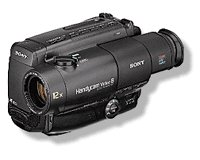Patented shortly after the turn of the century the technical process used in Nickel Cadmium battery packs has proved its worth for its attractive properties and long standing reputation. This tried and tested technical process has proved its ability to provide high capacity, long life and good reliability. Power capacity is measured in milliampers and the higher the number the longer the running times.1,000 milliampers (1,000mAh) equals one ampere, this is the current flowing per hour, thus 1,000mAh will run a camcorder rated at 6 watts 6 volts for one hour. An easy way to put it is the way DSM now mark some batteries as 12Wh, that is 12 watts per hour, so at a 6 watt camcorder consumption, you would get 2 hours running time.
Other factors must be taken into consideration when calculating running times. Switching a camcorder on and off produces surges which draw more current. Zooming, temperature, altitude, standby use all use energy adding to power consumption.
A camcorder will not drain a battery to a full discharge state, if it did you may be unable to remove you tape so power cut off allows enough power remaining to do this. So never expect that you will ever get running times as stated by the makers of your camcorder, but allow for conditions of use. Most manufacturers overstate recording times as a selling point. These are tested in a laboratory fixed on a static chart in ideal conditions and straight uninterrupted record without even varying the lighting.
You may have heard of the 'memory effect', which can occur with ni-cads when you find your running times getting shorter and shorter. But don't confuse this with shorter running times of an older battery, this is normal as a battery ages whatever the chemical construction. To help eliminate this effect in good batteries there are a few things you can do.Use a discharger now and then, recharge and discharge again then store your battery. Do not top charge unless your charger has a slow charge facility. If you own a slow charger use this as much as possible. One of the problems here is your fast charger nice for convenience but hard on batteries.
DSM and DTVS do overcome this discharge problem by providing special batteries. DSM add an extra cell to some of their batteries and belts, which leave the cells at normal discharge on camera cut off ( no need to discharge). A 7.2 volt battery is available from DSM which has a socket on it allowing the use of a slow charger, and providing about 30% better recording times.The higher voltage does not harm your camcorder.
Power belts and packs are a good way of getting more power without the need
for on board batteries. These are ideal when you need to do a lot of recording
or going abroad. DSM provide quite a large range of this type of thing for
most camcorders. They include an on board double battery system with slow
charging besides their usual range of power
belts.
SEALED LEAD ACID
Remember the old lead acid batteries used in cars where you had to top them up with distilled water? The sealed lead acid is a leak proof variation of these, now used in cars also.They contain instead of sulphuric acid impregnated pads or gel between plates which are as usual made from lead and copper.Unlike ni-cads these batteries must remain charged at all times and must not be left uncharged. Even though they tend to be quite heavy very long running times can be achieved DTVS do a staggering 12,000mAh one for 6 or 4.8 volt users. This is carried in a pouch for shoulder/belt operation. Unlike ni-cads top charging is no problem, and if cared for 5-10 year life is possible.
NICKEL METAL HYDRIDE ( Ni-MH )
This type of battery is gaining ground because of its lower weight to power ratio. Not proved to have any other advantage over ni-cads apart from the fact they have no memory effect, in fact its self discharge rate is disastrous. At the moment its cost is about a third more than ni-cads. Many of the older NiCad fits are now being made in Ni-MH as well so the choice is yours between cost and size. A new full selection are now available from DTVS.
LITHIUM ION
Again a light weight package used by all the top camcorder manufacturers like Sony, Panasonic, and JVC.At the moment these batteries are very expensive. At DTVS an ever increasing range of Li-ion batteries are now being supplied, and one is available for almost every model on the market that uses them. See the latest selection chart. selection chart Since first writing DTVS has now reduced prices on many Lithium ion batteries and introduced a new range of Camera and Mini Disc batteries.
THE FUTURE
A new type of battery is now being developed which was invented in the USA. Its polymer construction will allow it to be moulded into almost any shape. This could mean the camera mouldings being the battery itself, this being great if the battery lasts out the camcorder life. Another new battery technology is being developed by Toshiba using methanol. Toshiba states these batteries could offer up to five times the operating life of ordinary lithium ion batteries. Not sure whether this means increased capacity or a longer active life. It could be a few years before these reach the market place.
Additional instructions for charging NiMH batteries.
Due to the different chemical structure of Nickel Metal Hydride batteries some extra information regarding charging methods is required. Many NiCads have now been replaced with NiMH types giving many advantages such as no voltage depression problems, and less bulk to power ratio.
However problems do arise mainly because the original chargers supplied with
the camcorder were designed to charge NiCads only. This does not always mean
that the new battery cannot be charged on the original charger however. Yet
it may be found that the charger does not respond in the correct way it did
with NiCads.
The results of this is perfectly good NiMH batteries being returned as faulty
which is not the case.
Know your charger
Firstly you must know your charger even though it is a simple device and because it is used very little it's quite easy to forget what the two or three lights signify when charging. On most models there is a mains on and a charger light the latter staying lit or blinking during charge. At full charge this light will either go out or stop blinking so check which system you have first.
Problems
Q At switch on the mains indicator comes on, after insertion of the battery
the charge light comes on as normal but after a few minuets the mains light
flashes.
A If this happens remove battery switch off charger for 15 sec, switch
charger on again and reinsert battery.
Q After 30 mins or so the charger light goes out but the battery is not fully
charged.
A Unclip the battery and reinsert it should then charge to full (see
below).
Q The battery got hot and the charge light went out.
A On some chargers the charge will re commence when the battery cools.
If this does not happen reinsert battery pack until full charge time is reached
(see below).
Q Can I use the battery pack immediately after charge.
A No you should allow it to cool and some batteries VIVANCO will not allow
use for 30 minuets after charge which is normal.
Charging times
Because the original charger was designed for NiCAds the function light may not go out or stop flashing at full charge. In this case follow the charging times below.
1,800mAh 1hr 25mins
3,600mAh 2hr 50mins
This is for a normal original charger charging at 1.3 amps 1,300mAh, check the charge rate on the under plate of the charger, divide this figure into the battery capacity to give charging times. A universal charger will take longer check the makers instructions under specification.
Charging rates
Universal Chargers 800-1,000mA
Original chargers 1,300- 1,700mA
Note: If you intend to charge both NiCads and NiMH or just NiMH types it is recommended that you buy a universal charger that is both NiCad and NiMH compatible.
WARNING
If the charger light has not gone out or stopped flashing after above stated times remove the battery.
 Help tips are welcome if you have any please
send them in so I can put them on my pages.
Help tips are welcome if you have any please
send them in so I can put them on my pages.


